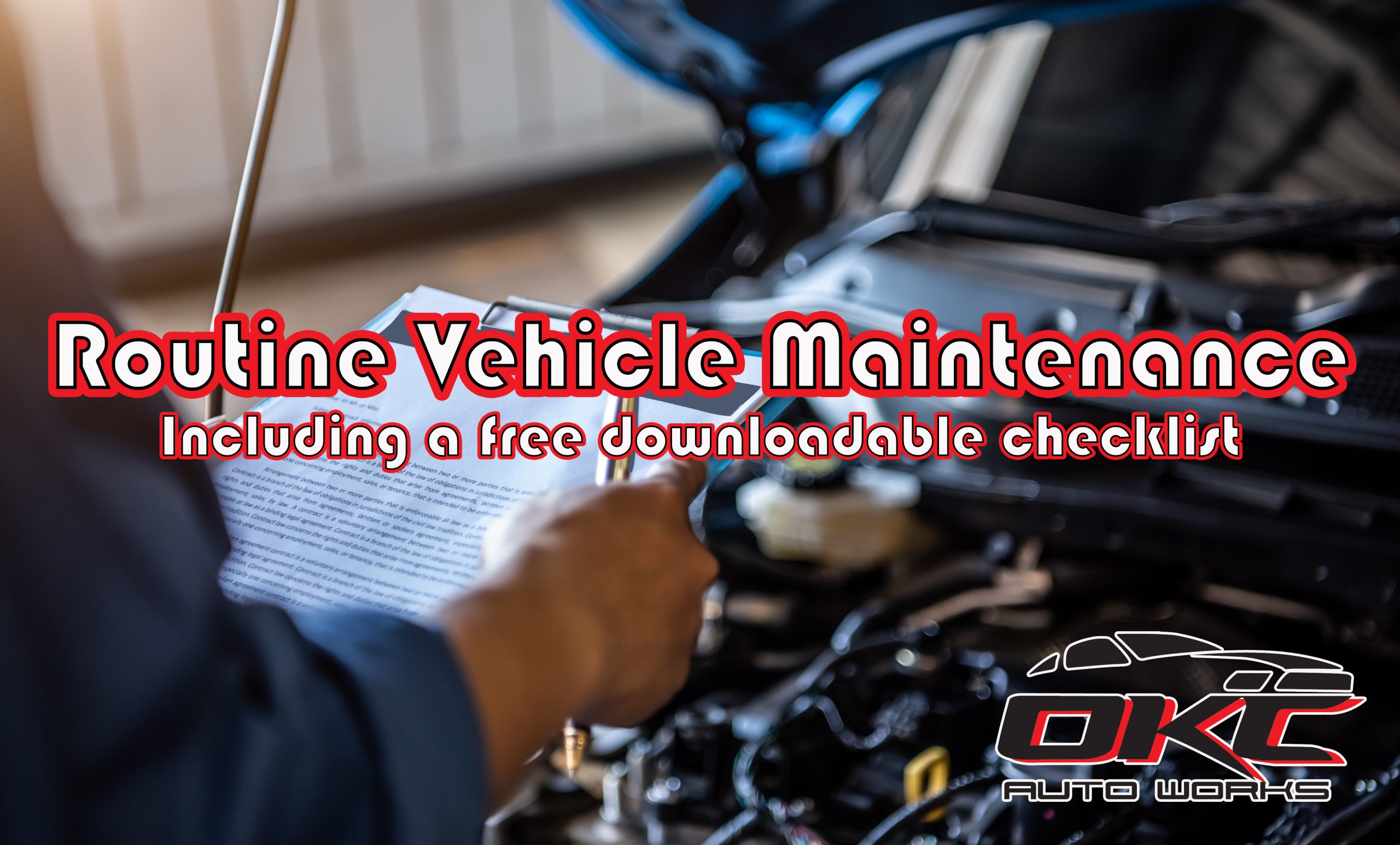Vehicle maintenance can seem scary & overwhelming, but it doesn’t need to be. There are some simple things you can do yourself that will help your vehicle run longer and handle better. Do the items you’re most comfortable with and leave the bigger stuff to your trusted OKC Auto Works service technician. Post this routine vehicle maintenance chart on your garage wall, using it to keep track of the maintenance items for your vehicle.
What to check monthly:
“Check Engine” Light
Watch for this or any other lights or messages that come on taking appropriate action. If the light is flashing, get service immediately.
Lights
Be certain that all lights are clean and working, including your headlights, tail/brake lights, turn signals, and emergency flashers.
Tire Pressure & Condition
Keep a tire pressure gauge in your glove compartment. To find out what the proper tire pressure is for your vehicle you can look in your car’s maintenance guide or for a decal usually found on the driver’s side door jamb. Ignore the tire pressure number on the sidewall of your tire, that is not the correct tire pressure for your vehicle, but instead is the max pressure the tire can hold. The manufacture’s guide is specific to your vehicle and should be followed. Additionally, you should inspect your tires for any uneven wear, cuts, bulges, nails, or other foreign objects.
Windshield Washer Fluid
Unscrew the wiper fluid reservoir and re-fill to the level indicated. While you are at it, pour some on a rag and use it to clean the bugs and other stuff off your wiper blades.
What to check every 3 months or 3,000 miles (In addition to all the above):
Air Filter (Engine)
It is a good idea to have the engine’s air filter checked every time you have your oil changed. If it is dirty, leaking, torn, oil-soaked, or wet, you should have it replaced. We suggest replacing it on an annual basis at minimum.
Automatic Transmission Fluid
While the engine is running but your vehicle is in ‘park’, raise the hood and check the fluid level. Add fluid if it is low. You can find out what type of fluid is recommended in your owner’s manual. Change the transmission fluid every 2 years or 24,000 miles, unless your manual tells you otherwise.
Battery & Cables
It is a good idea to have your battery checked everytime you have your oil changed. It is important to ensure that the connections are clean and tight as well as checking for signs of corrosion or leaking. If your battery is 3 years old or older, you may want to consider going ahead and replacing it.
Belts
Replace engine belts when they show any signs of wear, such as cracking, pilling, fraying, or you see contaminants such as gravel, sand, or oil. Also, replace if the timing belt appears too loose. Timing belts should be replaced according to the schedule in your owner’s manual – usually between 60,000 and 90,000 miles. Remember, your owner’s manual offers general guidelines. If you see or feel any signs of wear, have your engine belts checked and replaced immediately. DO NOT wait for your recommended service schedule date
Also keep in mind that some timing belt problems aren’t always visible and could be caused by other related components, such as a failing belt tensioner. Ask your automotive service technician to take a quick look at the entire drive system while he’s checking your engine belts.
Exhaust
When the car is cool, look for leaks, cracks, or any other signs of damage or broken supports. (You might suspect an exhaust leak if you hear an unusual ‘throttle’ or muffler sound when the car is running). Exhaust leaks can be very dangerous — take your car to a professional service technician ASAP if you suspect problems with your exhaust system.
Fuel Filter
Check the engine fuel filter at every oil change. Generally, fuel filters should be changed once a year on cars with
carburetors; every 2 years or 24,000 miles on cars with fuel injection.
Hoses
Inspect engine hoses at each oil change and have them replaced if you or your automotive technician sees any cracks, cuts, abrasions, or bulges, or if they feel excessively soft or mushy. Even the best coolant hose can fail without warning — and many problems aren’t always visible or could be caused by other related engine components. Ask your automotive service technician to take a quick look at your entire car cooling system while he’s checking your hoses.
Oil & Filter
Change your oil and filter every 3,000 miles or consult your owner’s manual for the recommended oil change schedule for your car and follow it closely. Keep in mind that you may see two recommended oil change schedules, one for normal driving and another for severe driving conditions. If you idle excessively, often drive in stop-and-go traffic or under extreme weather conditions, you should consider the severe driving schedule.
Synthetic oils may extend the number of miles between oil changes, but it’s more important to weigh your manufacturer’s recommendations and your driving conditions against the longer interval. In between oil changes, try checking your oil level when you fill-up with gas (and while the engine is off).
Power Steering Fluid
Check the level of your powering steering fluid while checking other fluids under the hood (and when your car is warmed up). If the level is low, add the correct type of fluid. If you’re topping off the level regularly, you might have a leak and should see a certified automotive service technician.
What to check every 6 months or 6,000 miles (In addition to all of the above):
Chassis Lubrication
If you have a new car, chances are it’s lubed-for-life and no action is necessary. If you have an older car, steering, and suspension systems may need periodic lubrication. Check your owner’s manual for specifics.
Polish
Regular vehicle washing is a must to keeping your vehicle’s paint and exterior in tip-top share. Use products specific to cleaning a vehicle rather than the stuff found in your kitchen. After a wash, you will want to polish your vehicle at least twice a year to protect and maintain the exterior finish.
Wiper Blades
Wiper blades typically last an average of 6-12 months. It is a good idea to replace them every fall ahead of more severe weather, such as what one would expect in winter. Replace them if they are cracked, cut, torn, streaking, chattering (jumping across your windshield), or if visibility is an issue.
What to check every 12 months or 12,000 miles (In addition to all of the above):
Air Filter (Cabin)
Cabin air filters have an important job, they help to clean the air that passengers breathe. You should consider replacing this at least once a year and potentially more often if you have pets that ride in your vehicle or have allergies. You may also need to replace it more often if you live in areas with heavy pollution or contaminated areas. Also, check the cabin air filter if your heater or air conditioner does not seem to be running as efficiently.
Antifreeze (Coolant)
Before checking the level of antifreeze, make sure the car is completely cool before unscrewing the radiator. If it’s low add a 50/50 mix of antifreeze and distilled water. You can purchase this pre-mixed or mix your own. Coolant should be changed annually. While this can be done anytime, most mechanics suggest doing it in cooler months.
Spark Plugs
In general, spark plugs need to be replaced between 30,000 to 100,000 miles. You will need to consult your owner’s manual for the specific change interval for your vehicle.
Steering & Suspension
The steering and suspension systems control where your vehicle goes and how well it drives getting there. These systems are two of the most important aspects of your safety when driving down the road. It is a good idea to have your tires inspected annually, however, if you notice any uneven tire wear, have a bouncy ride, or if your car squeals, shimmies, or vibrates, don’t wait. Go ahead and have your vehicle inspected. An inspection should include shock absorbers, struts, and chassis parts, as well as vehicle alignment.
While this schedule is a reliable but generic maintenance guide, your vehicle manual provided by the manufacturer is the ultimate guide as to what is best for your specific vehicle. If you do not feel comfortable performing your own maintenance, do not skip it. Bring it to your trusted mechanic or contact the trusted team at OKC Auto Works. Our service techs have your back. (405) 634-8200.




